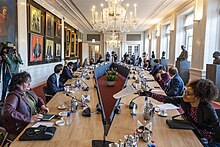
The formation of a Dutch cabinet is the process of government formation of a Dutch cabinet, consisting of ministers and state secretaries. Most cabinet formations take place after elections for the House of Representatives, but these can also take place in between.
There are no legal provisions outlining the specific process of forming a government. The only constitutional requirement is the appointment of ministers by the head of state at the end of the formation process. According to customary law, the confidence rule dictates that the new cabinet must have the support of the majority in parliament. Additionally, under the parliamentary system, there must be sufficient backing to pass legislation. These rules are complemented by conventions, traditions, and customs that have evolved and changed over time.

The formation can be roughly divided into three phases. In the scouting phase, a scout or informateur explores which political parties are willing to form a cabinet together. In the subsequent information phase, negotiations will take place under the leadership of an informateur about the government's future policy programme, to be recorded in a coalition agreement. During the formation phase, under the leadership of a formateur, the portfolios are determined, divided among the parties and ministers and state secretaries are sought. The specifics of each phase are flexible, and if a phase does not yield the desired outcome, the process can revert to an earlier phase. Ultimately, the appointed individuals are sworn in by the monarch. The formation concludes with a government's policy statement and debate in the House of Representatives.